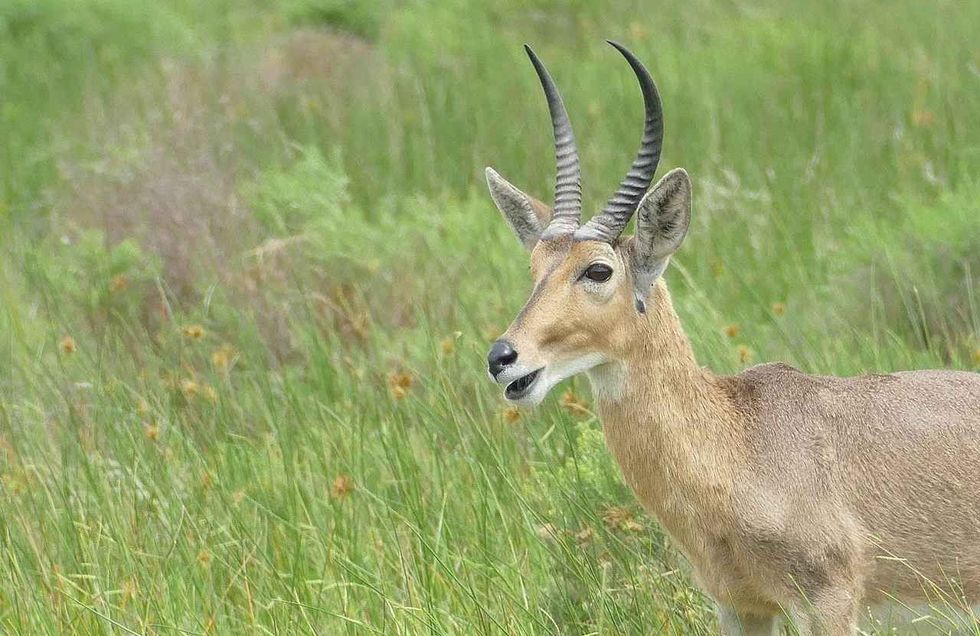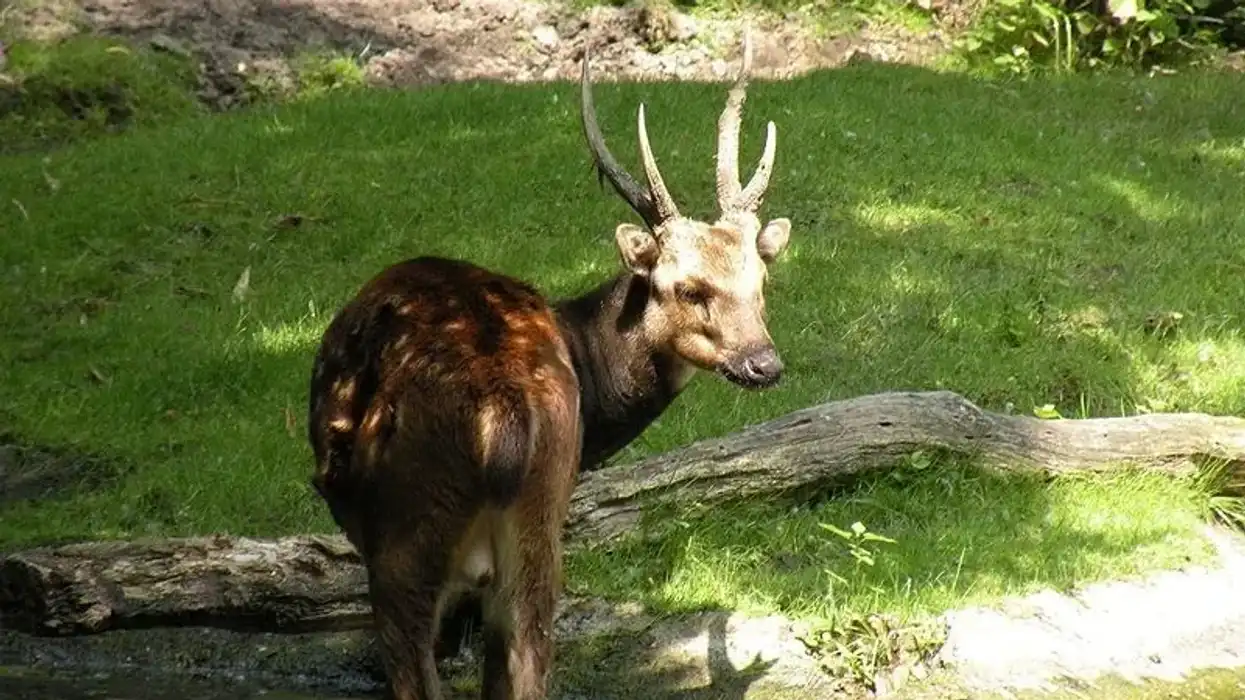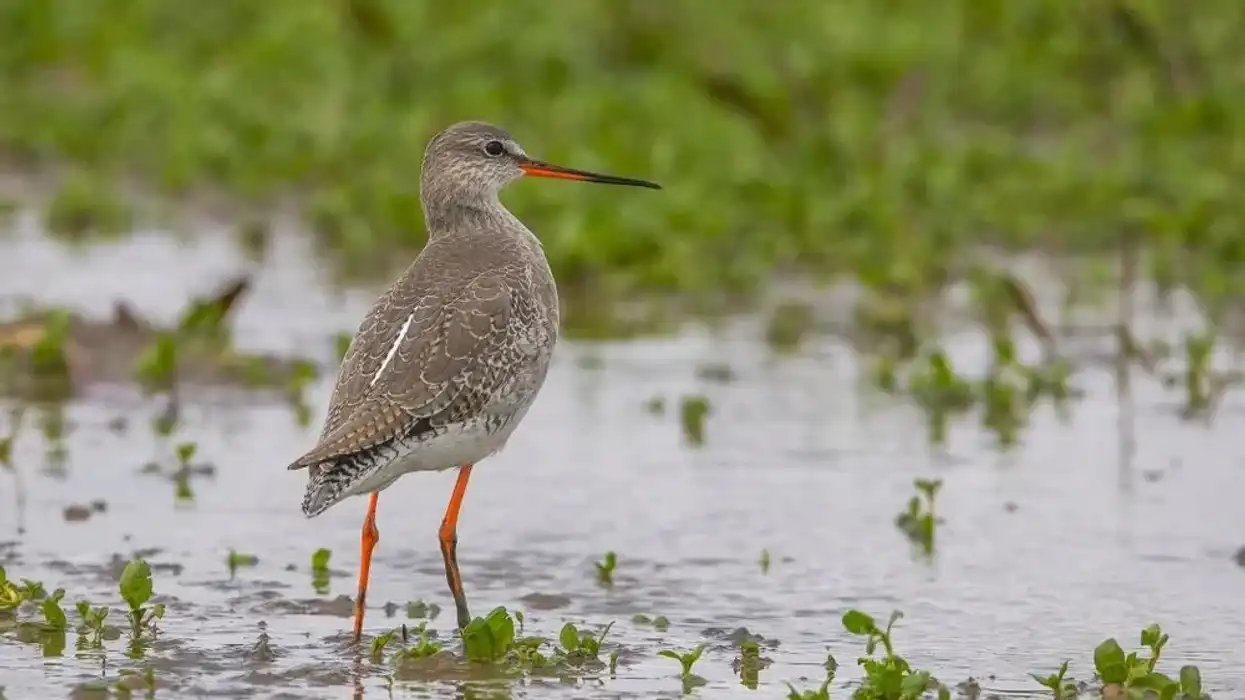The Southern reedbuck, also known as the common reedbuck or rietbok is an African antelope of the Redunca genus and Bovidae family. It is the largest reedbuck in its genus, which also contains the mountain reedbuck and the Bohor reedbuck.
It is native to Africa, mainly in south-central Africa, in the countries of Congo, Tanzania, Zimbabwe, Angola, Malawi, Zambia, Mozambique, and South Africa. They usually live in savannahs with tall grasses and reeds, where they can get cover from predators.
Depending on the seasons they may live alone, in pairs, or groups. They feed on grasses and reeds and are preyed upon by different predators, mainly cheetahs, leopards, and lions.
They are also considered game animals in Africa and their average lifespan is around 10-12 years in the wild. They are classified as a species of Least Concern by the IUCN.
Learn about other animals such as spiral-horned antelope and the Saiga antelope here too.
Southern Reedbuck Interesting Facts
What type of animal is a southern reedbuck?
The southern reedbuck (Redunca arundinum) is an antelope.
What class of animal does a southern reedbuck belong to?
The southern reedbuck (or the common reedbuck) belongs to the mammal class of animals.
How many southern reedbuck are there in the world?
There are estimated to be around 73,000 southern reedbuck individuals in the world.
Where does a southern reedbuck live?
The southern reedbuck (or the common reedbuck) lives in savannahs, woods, grasslands, and wetlands.
What is a southern reedbuck's habitat?
Southern reedbucks prefer savannas with lush vegetation with really tall grasses and reeds. They also are found in marshes, seasonally flooded valleys, woodlands, floodplains, and pastures.
Who does a southern reedbuck live with?
Southern reedbucks are found living alone, or with their mates and young during the wet season. In the winter, they live in groups of as many as 20 reedbucks
How long does a southern reedbuck live?
Southern reedbucks (Redunca arundinum) live for 10-12 years in the wild and 10-16 years in captivity.
How do they reproduce?
Southern reedbucks reproduce by mating throughout the year, but mostly in the wet and hot seasons. Females attain maturity after two years and males after three.
After mating, the male protects the female who is pregnant for seven to eight months, and then gives birth to a lamb. The lamb stays hidden for two months after birth and then joins his mother after that. They join the father after two more months.
What is their conservation status?
The conservation status of southern reedbucks according to the International Union for Conservation of Nature is Least Concern.
Southern Reedbuck Fun Facts
What do southern Reedbucks look like?
The southern reedbuck (Redunca arudinum, or the common reedbuck) is the biggest of the Redunca genus of the reedbuck species, and males are larger than females. Their coat color varies from yellowish-brown to grayish-brown, and their coat is very silky and woolly.
Southern Reedbucks have bushy tails with white undersides. Behind their ears is a black, small glandular patch.
The undersides of a southern reedbuck are white and so are their chin and the rings around their eyes. The sides of their heads have tan streaks, and their forelegs also have black and white markings. Male southern reedbucks have peculiar horns that form a shape of a 'V' and are 12-18 in (30-45 cm) long.
These horns have strong ridges and point backward. They begin from the head, curve up and extend outwards near the tips.

How cute are they?
Southern reedbucks are very cute animals that have beautiful, slender, regal bodies. Being antelopes, they are very graceful in their movement. The crowns of the males make them look like royals! Their big ears, light-colored colored coats, non-threatening presence, herbivorous diets, and almost-emotive faces make them very cute indeed.
How do they communicate?
In instances of fear, surprise, or greeting, a southern reedbuck lets out a loud whistle through its nostrils. It communicates using body language as well.
A free-hanging tail, forward-pointed ears, and erect head indicate a friendly meeting. At a time of fear and surprise, a southern reedbuck's ears and head will be pointed upwards, and it pronks to scare off intruders. They sniff and pronk as a part of their mating rituals as well.
How big is a southern reedbuck?
A southern reedbuck (Redunca arundinum) is about 52.76-65.75 in (134-167 cm) long, which makes it five to seven times bigger than a royal antelope.
How fast can a southern reedbuck run?
Its exact speed is undocumented, but being an antelope, the speed of a southern reedbuck can be assumed to be around 25-55 mph (40-90 kph).
How much does a southern reedbuck weigh?
The southern reedbuck weighs about 85.9-176.21 lb (39 to 80 kg).
What are the male and female names of the species?
Male and female southern reedbucks are called 'bucks' and 'does' respectively.
What would you call a baby southern reedbuck?
Baby southern reedbucks are called 'lambs'.
What do they eat?
Southern reedbucks are herbivores and they eat grasses, herbs, and reeds.
Are they dangerous?
Southern reedbucks are considered a game animal in Africa, so they are not a danger to humans but humans are a danger to them.
Would they make a good pet?
Southern reedbucks play a vital role in many African forest ecosystems that they live in and they are wild at heart, so they would not make a good pet.
Did you know...
Southern reedbucks are endemic to Africa, more specifically to south-central Africa.
The southern reedbuck (Redunca arundinum or common reedbuck) is a diurnal creature, meaning they sleep at night and are active during the daytime.
A mountain reedbuck (Redunca fulvorufula) is smaller than the southern reedbuck (or common reedbuck). The mountain reedbuck belongs to the Redunca family, the same as the common reedbuck, and the mountain reedbuck (Redunca fulvorufula) is endangered. The mountain reedbuck has three subspecies, the Adamawa mountain reedbuck, Chanler's mountain reedbuck, and the southern mountain reedbuck.
Southern reedbuck populations have declined in South Africa because of overexploitation and habitat loss. However, the Eastern Shores Park of South Africa still has a major population of them.
The mountain reedbuck (Redunca fulvorufula) is native to the mountains of sub-Saharan Africa. Reedbucks, in general, are found near the marshes of wetlands of sub-Saharan Africa.
The third member of the Redunca family is the Bohor reedbuck, which is classified by the IUCN as a species of Least Concern. It is found in many countries and ranges in Central Africa. The Bohor reedbuck has a higher survival rate than other reedbucks. It favors water more than other reedbucks as well.
Southern reedbucks breed throughout the year and the gestation period of the southern reedbuck is seven to eight months.
Southern Reedbucks form groups and herds during the dry season, but become territorial during the wet season.
The scientific name for southern reedbucks is Redunca arundinum, and the scientific name for the mountain reedbuck is Redunca fulvorufula. The scientific name for the Bohor reedbuck is Redunca redunca.
The Southern Reedbuck has a white underside. Its relatives, the Mountain Reedbuck, and the Bohor Reedbuck also have a white underside.
Southern Reedbucks belong to the Animalia Kingdom, phylum Chordata. Also, they are from the Mammalia class, order Artiodactyla. Mountain Reedbucks also belong to the Animalia Kingdom, phylum Chordata. They are from the Mammalia class, order Artiodactyla.
A male mountain reedbuck has horns but a female doesn't. Similar to southern reedbucks, males, and females of the mountain reedbuck family, both have dark scent patches.
The northern habitat range of the southern reedbuck is the Miombo Woodlands' edge. They are territorial creatures and the lifetime home range for mature females and males is 123 ha and 74 ha, respectively.
Reedbucks prefer lands with good vegetation and grasslands for feeding purposes. Another purpose for the grasslands and vegetation is to hide from predators. Their habitat ranges over African grasslands.
Southern reedbucks are common in many African national parks. In Tanzania, they are common in Selous National Park, in Zambia they are common in the Kafue National Park, in Malawi, they are common in the Nyika National Park, and in Mozambique, they are common in the Gorongosa National Park.
A female southern reedbuck performs a dance called pronking during mating and reproduction.
The behavior of these reedbucks changes with the seasons, as they are territorial in the wet season, and they are more sociable in the dry season, living in a group.
What eats southern reedbuck?
Southern reedbuck predators include leopards, cheetahs, lions, African wild dogs (Cape hunting dogs), pythons, servals, jackals, spotted hyenas, crocodiles, and humans.
Are southern reedbuck antelopes?
The southern reedbuck is the biggest antelope species in the genus Redunca. The Redunca genus gets its name from the Latin words, 'reduncas' and ''arundo', meaning 'bent backward' and 'reeds' respectively.
Here at Kidadl, we have carefully created lots of interesting family-friendly animal facts for everyone to discover! Learn more about some other mammals from our Sonoran pronghorn facts and mountain lion facts pages.
You can even occupy yourself at home by coloring in one of our free printable southern reedbuck coloring pages.
You can even occupy yourself at home by drawing one on our Mammals coloring pages.










